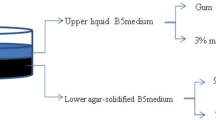Summary
Progeny analysis of androgenetic plants from inbred rape-seed (Brassica napus) shows that selective growth of microspores can occur in cultured anthers. The property of privileged growth in culture seems to be linked to such characters as flowering time and seed glucosinolate content which can be analyzed in regenerated plants. This type of selection and the fact that more variability is visible in regenerants from different microspores than in the progeny of the highly inbred anther donor line, demonstrates the higher degree of homozygosity in the doubled amphihaploids of B. napus. Furthermore, it is shown that haploid genomes of rape may be mutable. Thus it is possible to obtain several different homozygous lines from a single microspore. A system of haploid embryoids arising from single cells of the primary microspore regenerant has also been used to produce experimentally induced mutants. It is demonstrated that recessive mutations can be obtained in a homozygous state in doubled haploid regenerants from mutagenized haploid single cells.
Similar content being viewed by others
Literature
Davis, B.J. (1964): Disc electrophoresis. II. Method and application to human serum proteins. Ann. N. Y. Acad. Sci. 121, 404–427
Hansson, B. (1978): Temperaturchocker — ett sätt att kraftigt höja frekvensen embryoidbildningar vid antherkultur av raps (Brassica napus). Sver. Utsädesfören. Tidskr. 88, 141–148
Hoffmann, F. (1978): Mutation and selection of haploid cell culture systems of rape and rye. In: Production of Natural Compounds by Cell Culture Methods (eds. Alfermann, A.W.; Reinhard, E.), pp. 319–329. München: Ges. f. Strahlen- und Umweltforsch.
Hoffmann, F. (1980): Pflanzliche Zellkulturtechniken als Züchtungsschritt am Beispiel Raps. Naturwissenschaften 67, 301–306
Hoffmann, F.; Schenck, H.; Kohlenbach, H.W.; Gleba, Y.Y. (1980): Regeneration and fusion of protoplasts from important crop plants of the Brassiceae. In: Advances in Protoplast Research (eds. Ferenczy, L.; Farkas, G.L.), pp. 287–292. Oxford: Pergamon Press
Kartha, K.K.; Gamborg, O.L.; Constabel, F. (1974): In vitro plant formation from stem explants of rape (Brassica napus cv. ‘Zephyr’). Physiol. Plant. 31, 217–220
Kartha, K.K.; Gamborg, O.L.; Constabel, F.; Kao, K.N. (1974a): Fusion of rape seed and soybean protoplasts and subsequent division of heterokaryocytes. Can. J. Bot. 52, 2435–2436
Kartha, K.K.; Michayluk, M.R.; Kao, K.N.; Gamborg, O.L.; Constabel, F. (1974b): Callus formation and plant regeneration from mesophyll protoplasts of rape plants (Brassica napus cv. ‘Zephyr’). Plant Sci. Lett. 3, 265–271
Keller, W.A.; Armstrong, K.C. (1977): Embryogenesis and plant regeneration in Brassica napus anther cultures. Can. J. Bot. 55, 1383–1388
Keller, W.A.; Armstrong, K.C. (1978): High frequency production of microspore-derived plants from Brassica napus anther cultures. Z. Pflanzenzücht. 80, 100–108
Kohlenbach, H.W.; Wenzel, G.; Hoffmann, F. (1982): Regeneration of Brassica napus plantlets in cultures from isolated protoplasts of haploid stem embryos in comparison to the behaviour of leaf protoplasts. Z. Pflanzenphysiol. (in press)
Larkin, P.J.; Scowcroft, W.R. (1981): Somaclonal variation — a novel source of variability from cell cultures for plant improvement. Theor. Appl. Genet. 60, 197–214
Lein, K.-A. (1972): Zur quantitativen Bestimmung des Glucosinolatgehaltes in Brassica-Samen. 1: Gewinnung und Reinigung der Myrosinase. Angew. Bot. 46, 137–159
Lein, K.-A. (1972a): Zur quantitativen Bestimmung des Glucosinolatgehaltes in Brassica-Samen. 2: Photometrische Bestimmung des Gesamtglucosinolat-, des Thiooxazolidonund des Isothiocyanatgehaltes in einem Testansatz. Angew. Bot. 46, 263–284
Lichter, R. (1981): Anther culture of Brassica napus in a liquid culture medium. Z. Pflanzenphysiol. 103, 229–237
Maurer, H.R. (1968): Disk-Elektrophorese. Berlin: de Gryter
MacGibbon, D.B.; Allison, R.M. (1970): A method for the separation and detection of plant glucosinolases (myrosinases). Phytochem. 9, 541–544
Renard, M.; Dosba, F. (1980): Étude de l'haploidie chez le Colza (Brassica napus var. “oleifera’). Ann Amélior. Plantes 30, 191–209
Röbbelen, G. (1975): Totale Sortenumstellung beim Körnerraps, pp. 119–146, Ber. Arbeitsgg. AG. Saatzuchtleiter, Gumpenstein
Sacristan, M.D. (1981): Regeneration of plants from long-term callus cultures of haploid Brassica napus. Z. Pflanzenzücht. 86, 248–253
Sacristan, M.D.; Hoffmann, F. (1979): Direct infection of embryogenic tissue cultures of haploid Brassica napus with resting spores of Plasmodiophora brassicae. Theor. Appl. Genet. 54, 129–132
Stringam, G.R. (1977): Regeneration in stem explants of haploid rapeseed (Brassica napus). Plant Sci. Lett. 9, 115–119
Stringam, G.R. (1979): Regeneration in leaf-callus cultures of haploid rapeseed. Z. Pflanzenphysiol. 92, 459–462
Thies, W. (1971): Schnelle und einfache Analysen der Fettsäurezusammensetzung in einzelnen Raps-Kotyledonen. 1: Gaschromatographische und papierchromatographische Methoden. Z. Pflanzenzücht. 65, 181–202
Thies, W. (1977): Analysis of glucosinolates in seeds of rapeseed (Brassica napus): concentration of glucosinolates by ion exchange. Z. Pflanzenzücht. 79, 331–335
Thomas, E.; Wenzel, G. (1975): Embryogenesis from microspores of Brassica napus. Z. Pflanzenzücht. 74, 77–81
Thomas, E.; Hoffmann, F.; Potrykus, L.; Wenzel, G. (1976): Protoplast regeneration and stem embryogenesis of haploid androgenetic rape. Mol. Gen. Genet. 145, 245–247
Wenzel, G.; Hoffmann, F.; Thomas, E. (1976): Heterozygous microspore-derived plants in rye. Theor. Appl. Genet. 48, 205–208
Wenzel, G.; Hoffmann, F.; Thomas, E. (1977): Anther culture as a breeding tool in rape. I. Ploidy level and phenotype of androgenetic plants. Z. Pflanzenzücht. 78, 149–155
Wenzel, G.; Uhrig, H. (1981): Breeding for nematode and virus resistance in potato via anther culture. Theor. Appl. Genet. 59, 333–340
Author information
Authors and Affiliations
Additional information
Communicated by D. von Wettstein
Part of the material analyzed in this work was produced under the guidance of Emrys Thomas when he was one of the project leaders of the “Projektgruppen Haploide in der Pflanzenzüchtung” at the Max-Planck-Institut für Pflanzengenetik in Ladenburg. His untimely death at the age of 36 (May 23, 1981), which overtook him at his new place of work at Harpenden, prevented him seeing the completion of this paper. It is dedicated to the memory of this distinguished and restless researcher and highly-valued colleague
Rights and permissions
About this article
Cite this article
Hoffmann, F., Thomas, E. & Wenzel, G. Anther culture as a breeding tool in rape. Theoret. Appl. Genetics 61, 225–232 (1982). https://doi.org/10.1007/BF00273779
Received:
Issue Date:
DOI: https://doi.org/10.1007/BF00273779




